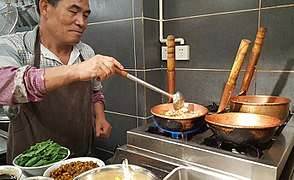| English | Traditional Chinese | Simplified Chinese | Pinyin | Origin | Description |
| Baba | 粑粑 | 粑粑 | bābā | Naxi | A thick, round and heavy bread, either prepared plain or with various fillings. |
| Banana flower | 芭蕉花 | 芭蕉花 | bājiāo huā | Dai/Zhuang people | The heart of the banana flower. Frequently eaten roasted in banana leaves on an open barbecue, but also stir-fried. |
| Pineapple rice | 菠蘿飯 | 菠萝饭 | bōluó fàn | Dai people | Pineapple rice. It is found in Xishuangbanna and other areas populated by Dai people. |
| Erkuai | 餌塊 | 饵块 | ěrkuài | Bai people (Dali Prefecture) | Highly refined and compressed rice cakes. |
| Crossing the bridge noodles | 過橋米線 | 过桥米线 | guò qiáo mǐxiàn | Han Chinese | Literally means "crossing the bridge noodles" or "across the bridge noodles". It is Yunnan's best known dish. It typically consists of a bowl of boiling chicken soup, to which diners add their own selection of thin meat slices, mixian, vegetables and spices, much like a hot pot. It is ubiquitous throughout the province. |
| Adzuki beans | 紅豆 | 红豆 | hóngdòu | | Adzuki beans have been used in Yunnan for millennia. Earliest domesticated examples are known from tombs in Japan (4,000 BCE), then China and Korea (3,000 BCE). Genetic evidence indicates that the bean later crossbred with native species in the Himalayas, and Yunnan was probably exposed to the ingredient at the time. Frequently prepared fried with kale or mint. |
| Jidou liangfen | 雞豆涼粉 | 鸡豆凉粉 | jīdòu liángfěn | Naxi people (Lijiang) | A savoury jelly made from gram flour. |
| Juecai | 蕨菜 | 蕨菜 | juécài | In high altitudes, often the first green growth in spring. | Immature fronds of bracken ferns, such as osmunda japonica.[3] Stir-fried or in soup. |
| Granny's potato | 老奶洋芋 | 老奶洋芋 | lǎonǎi yángyù | | A local mashed potato style dish typically flavoured with spring onions and chilli. |
| Lufu | 滷腐 | 卤腐 | lǔfǔ | Northern China, via the Mongols (during the Yuan dynasty) | A type of fermented beancurd, typically used as a condiment or made into sauces, often used on erkuai. It is reddish-yellow in colour, with a soft texture and a savoury flavour. |
| Migan / Mixian | 米干 / 米線 | 米干 / 米线 | mǐgàn / mǐxiàn | Dai people / Han Chinese | Fresh Yunnanese rice noodles, typically served either in a soup of broth or stir-fried. |
| Peanuts | 花生 | 花生 | huāshēng | Re-introduction?[4][5] | Eaten fried as a condiment, as a component in fried noodles, cold noodles, noodle soups, stir-fries and fried rice. |
| Pu'er tea | 普洱茶 | 普洱茶 | pǔ'ěr chá | Han Chinese (Ning'er) | Famous dark tea that had gained popularity worldwide for its health benefits. |
| Steam pot chicken | 氣鍋雞 | 气锅鸡 | qì guō jī | Han Chinese (Jianshui) | Literally means "steam pot chicken". It consists of chicken steamed with tonics and herbs in a ceramic pot. |
| Rubing | 乳餅 | 乳饼 | rǔbǐng | Bai people (Dali Prefecture) | Cheese made from goat's milk. |
| Rushan | 乳扇 | 乳扇 | rǔshān | Bai people (Dali Prefecture) | Cheese made from cow's milk. |
| Shiping tofu | 石屏豆腐 | 石屏豆腐 | shípíng dòufǔ | Han Chinese via the Mongols (Shiping) | Traditional bean curd made in Shiping County, dating from the Yuan dynasty. |
| Xuanwei ham | 宣威腿 | 宣威腿 | Xuānwēi tuǐ | Han Chinese (Qujing) | Traditional ham made in Xuanwei, a county-level city in Qujing. It dates from the Ming dynasty. |
| Yiliang roast duck | 宜良烤鴨 | 宜良烤鸭 | yíliáng kǎoyā | Han Chinese (Yiliang) | A crispy skin roast duck similar to Peking duck, but honey is used to crisp and colour the skin. It is roasted with pine branches and needles, which impart a unique flavour to the dish. |
| Zhe'ergen | 折耳根 | 折耳根 | zhé'ěrgēn | Yelang | An edible rhizome with a fresh, spicy and peppery flavour. The leaves are also eaten. |
| Crisp Stuffed Bun | 破酥包 | 破酥包 | pòsūbāo | Han Chinese | A lard-layered bun with pork, lard, bamboo shoot, and soy sauce; or with the filling of Yunnan ham and white sugar or brown sugar. Poshu Bun was created by a chef from Yuxi almost a hundred years ago. |

